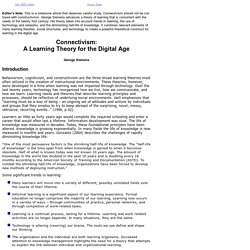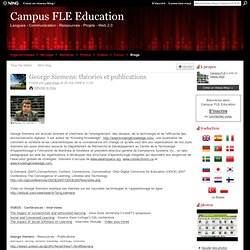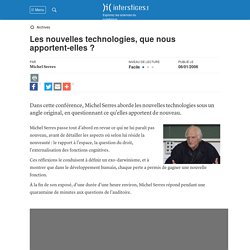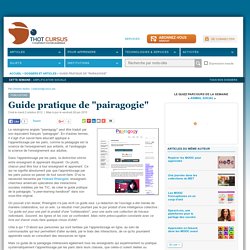

Mooc ITyPA 2 : jetez vous à l’eau ! Article Gilliot Jean Marie. Article Siemens Georges (Ang) Editor’s Note: This is a milestone article that deserves careful study.

Connectivism should not be con fused with constructivism. George Siemens advances a theory of learning that is consistent with the needs of the twenty first century. His theory takes into account trends in learning, the use of technology and networks, and the diminishing half-life of knowledge. It combines relevant elements of many learning theories, social structures, and technology to create a powerful theoretical construct for learning in the digital age. George Siemens Introduction Behaviorism, cognitivism, and constructivism are the three broad learning theories most often utilized in the creation of instructional environments. Connectivism_Week1. Everything elearning: About George Siemens. About George Siemens George Siemens, Founder and President of Complexive Systems Inc., a research lab assisting organizations to develop integrated learning structures for global strategy execution.

In 2006 he authored a book - Knowing Knowledge (.pdf version available here)- an exploration of how the context and characteristics of knowledge have changed, and what it means to organizations today. In 2009, he published the Handbook of Emerging Technologies for Learning (.pdf version available here) with Peter Tittenberger. George is currently affiliated with the Technology Enhanced Knowledge Research Institute (TEKRI) at Athabasca University. His role as a social media strategist involves planning, researching, and implementing social networked technologies, with focus on systemic impact and institutional change.
Prior to TEKRI, he was the Associate Director, Research and Development with the Learning Technologies Centre at University of Manitoba. George Siemens: théories et publications. George Siemens est écrivain éminent et chercheur de l'enseignement, des réseaux, de la technologie et de l'efficacité des environnements digitaux.

Il est auteur de "Knowing Knowledge", une exploration de comment le contexte et les caracteristiques de la connaissance ont changé ce qu'elle veut dire aux organisations de nos jours. Siemens est aussi directeur associé du Département de Récherche et Développement au Centre de la Technologie d'Apprentissage à l'Université de Manitoba et fondateur et président-directeur général de Complexive Systems Inc., un labo pédagogique qui aide les organisations à développer des structures d'apprentissage integrées qui répondent aux exigences de l'éxecution globale de strategies.
Siemens s'occupe de www.elearnspace.org, www.connectivism.ca et www.knowingknowledge.com. G.Siemens (2007),Connectivism: Content, Connections, Conversation. Ohio Digital Commons for Education (ODCE) 2007 Conference The Convergence of Learning, Libraries and. What Connectivism Is. Posted to the Connectivism Conference forum (which hits a login window - click 'login as guest' (middle of the left-hand column) - I'm sorry, and I have already complained to the conference organizer).

At its heart, connectivism is the thesis that knowledge is distributed across a network of connections, and therefore that learning consists of the ability to construct and traverse those networks. It shares with some other theories a core proposition, that knowledge is not acquired, as though it were a thing. Hence people see a relation between connectivism and constructivism or active learning (to name a couple). Where connectivism differs from those theories, I would argue, is that connectivism denies that knowledge is propositional. That is to say, these other theories are 'cognitivist', in the sense that they depict knowledge and learning as being grounded in language and logic. Connectivism is, by contrast, 'connectionist'.
Response to comments by Tony Forster Response (1) to Bill Kerr. Openness and the Metaverse Singularity. The four worlds of the Metaverse Roadmap could also represent four pathways to a Singularity.

But they also represent potential dangers. An “open-access Singularity” may be the answer. The people who have embraced the possibility of a singularity should be working at least as hard on making possible a global inclusion of interests as they do on making the singularity itself happen, says Jamais Cascio. Originally presented at Singularity Summit 2007, September 8, 2007. Reprinted with permission on KurzweilAI.net November 7, 2007. I was reminded, earlier this year, of an observation made by polio vaccine pioneer Dr. This is a particularly relevant question for those of us here at the Summit. It’s not an easy question to answer, in part because it can be an uncomfortable examination.
Which is why I’m going to talk a bit about video games. Earlier this year, I co-authored a document that I know some of you in the audience have seen: the Metaverse Roadmap Overview. 'Open Teaching': When the World Is Welcome in the Online Classroom - Technology. By Marc Parry In his work as a professor, Stephen Downes used to feel that he was helping those who least needed it.

His students at places like the University of Alberta already had a leg up in life and could afford the tuition. So when a colleague suggested they co-teach an online class in learning theory at the University of Manitoba, in 2008, Mr. Downes welcomed the chance to expand that privileged club. The idea: Why not invite the rest of world to join the 25 students who were taking the course for credit? Over 2,300 people showed up. They didn't get credit, but they didn't get a bill, either. The Downes-Siemens course has become a landmark in the small but growing push toward "open teaching. "
Lifelong Kindergarten. Learning Circuits. Conf. Sugata Mitra aux Assises de l'éducation et de la formation numériques. Sugata Mitra: The child-driven education. Conf. Michel Serres : Les nouvelles technologies, que nous apportent-elles ? Dans cette conférence, Michel Serres aborde les nouvelles technologies sous un angle original, en questionnant ce qu'elles apportent de nouveau.

Michel Serres passe tout d'abord en revue ce qui ne lui paraît pas nouveau, avant de détailler les aspects où selon lui réside la nouveauté : le rapport à l'espace, la question du droit, l'externalisation des fonctions cognitives. Guide pratique de "pairagogie" Le néologisme anglais "peeragogy" peut être traduit par son équivalent français "pairagogie".

Linked'In Ing .Pédagogiques. WikiMindMap du Mooc.
Mon MOOC à moi c'est toi...